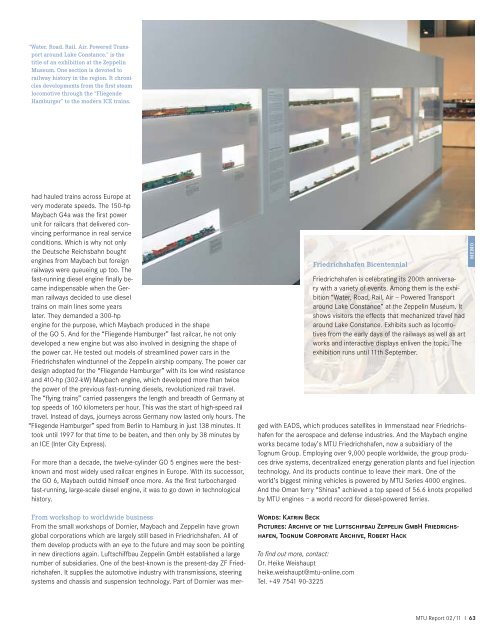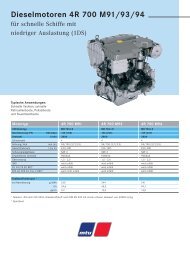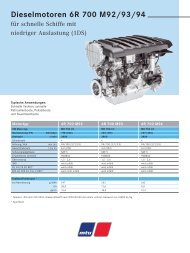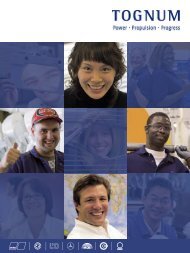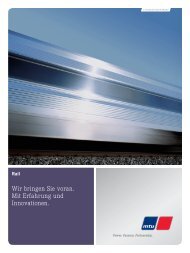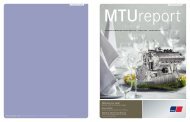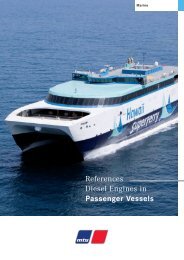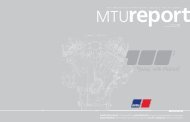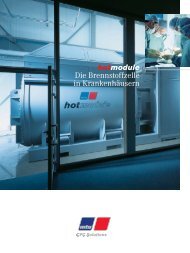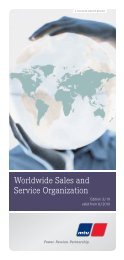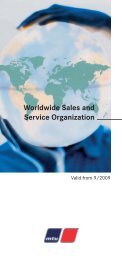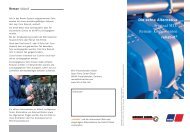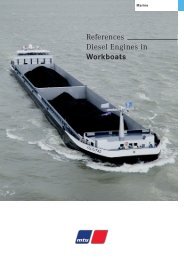Create successful ePaper yourself
Turn your PDF publications into a flip-book with our unique Google optimized e-Paper software.
“Water. Road. Rail. Air. Powered Transport<br />
around Lake Constance.” is the<br />
title <strong>of</strong> an exhibition at the Zeppelin<br />
Museum. One section is devoted to<br />
railway history in the region. It chronicles<br />
developments from the first steam<br />
locomotive through the “Fliegende<br />
Hamburger” to the modern ICE trains.<br />
had hauled trains across Europe at<br />
very moderate speeds. The 150-hp<br />
Maybach G4a was the first power<br />
unit for railcars that delivered convincing<br />
performance in real service<br />
conditions. Which is why not only<br />
the Deutsche Reichsbahn bought<br />
engines from Maybach but foreign<br />
railways were queueing up too. The<br />
fast-running diesel engine finally became<br />
indispensable when the German<br />
railways decided to use diesel<br />
trains on main lines some years<br />
later. They demanded a 300-hp<br />
engine for the purpose, which Maybach produced in the shape<br />
<strong>of</strong> the GO 5. And for the “Fliegende Hamburger” fast railcar, he not only<br />
developed a new engine but was also involved in designing the shape <strong>of</strong><br />
the power car. He tested out models <strong>of</strong> streamlined power cars in the<br />
Friedrichshafen windtunnel <strong>of</strong> the Zeppelin airship company. The power car<br />
design adopted for the “Fliegende Hamburger” with its low wind resistance<br />
and 410-hp (302-kW) Maybach engine, which developed more than twice<br />
the power <strong>of</strong> the previous fast-running diesels, revolutionized rail travel.<br />
The “flying trains” carried passengers the length and breadth <strong>of</strong> Germany at<br />
top speeds <strong>of</strong> 160 kilometers per hour. This was the start <strong>of</strong> high-speed rail<br />
travel. Instead <strong>of</strong> days, journeys across Germany now lasted only hours. The<br />
“Fliegende Hamburger” sped from Berlin to Hamburg in just 138 minutes. It<br />
took until 1997 for that time to be beaten, and then only by 38 minutes by<br />
an ICE (Inter City Express).<br />
For more than a decade, the twelve-cylinder GO 5 engines were the bestknown<br />
and most widely used railcar engines in Europe. With its successor,<br />
the GO 6, Maybach outdid himself once more. As the first turbocharged<br />
fast-running, large-scale diesel engine, it was to go down in technological<br />
history.<br />
From workshop to worldwide business<br />
From the small workshops <strong>of</strong> Dornier, Maybach and Zeppelin have grown<br />
global corporations which are largely still based in Friedrichshafen. All <strong>of</strong><br />
them develop products with an eye to the future and may soon be pointing<br />
in new directions again. Luftschiffbau Zeppelin GmbH established a large<br />
number <strong>of</strong> subsidiaries. One <strong>of</strong> the best-known is the present-day ZF Friedrichshafen.<br />
It supplies the automotive industry with transmissions, steering<br />
systems and chassis and suspension technology. Part <strong>of</strong> Dornier was mer-<br />
Friedrichshafen Bicentennial<br />
Friedrichshafen is celebrating its 200th anniversary<br />
with a variety <strong>of</strong> events. Among them is the exhibition<br />
“Water, Road, Rail, Air – Powered Transport<br />
around Lake Constance” at the Zeppelin Museum. It<br />
shows visitors the effects that mechanized travel had<br />
around Lake Constance. Exhibits such as locomotives<br />
from the early days <strong>of</strong> the railways as well as art<br />
works and interactive displays enliven the topic. The<br />
exhibition runs until 11th September.<br />
ged with EADS, which produces satellites in Immenstaad near Friedrichshafen<br />
for the aerospace and defense industries. And the Maybach engine<br />
works became today’s <strong>MTU</strong> Friedrichshafen, now a subsidiary <strong>of</strong> the<br />
Tognum Group. Employing over 9,000 people worldwide, the group produces<br />
drive systems, decentralized energy generation plants and fuel injection<br />
technology. And its products continue to leave their mark. One <strong>of</strong> the<br />
world’s biggest mining vehicles is powered by <strong>MTU</strong> Series 4000 engines.<br />
And the Oman ferry “Shinas” achieved a top speed <strong>of</strong> 56.6 knots propelled<br />
by <strong>MTU</strong> engines – a world record for diesel-powered ferries.<br />
Words: Katrin Beck<br />
Pictures: Archive <strong>of</strong> the Luftschifbau Zeppelin GmbH Friedrichshafen,<br />
Tognum Corporate Archive, Robert Hack<br />
To find out more, contact:<br />
Dr. Heike Weishaupt<br />
heike.weishaupt@mtu-online.com<br />
Tel. +49 7541 90-3225<br />
MEMO<br />
<strong>MTU</strong> Report 02/11 I 63


